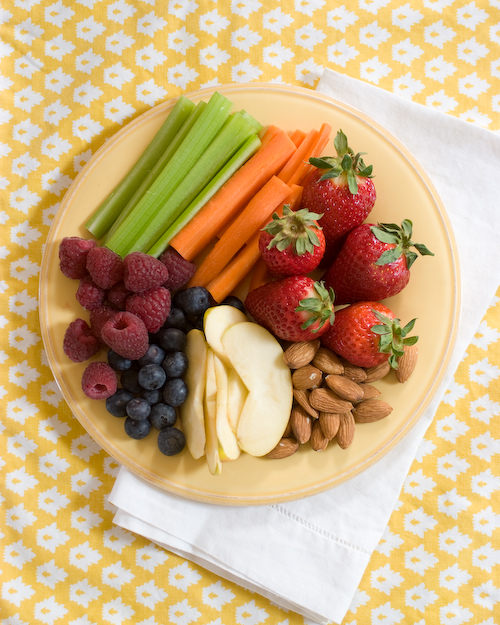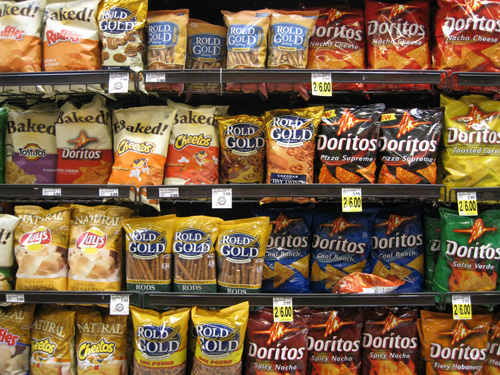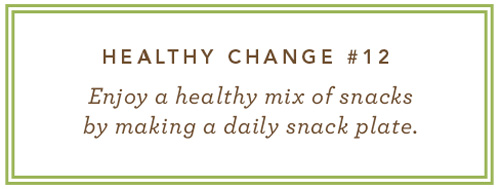The Joy of Snacking

The quick answer: Snacks are the barometer of a healthy diet. If you don’t eat well, you won’t snack well either.
______________________________________________________________________________________________
Our Goal
Eat smarter, look better, live longer—that’s the stated goal of this blog. If there’s a resource that will help you do it better than this blog, please tell us because we haven’t seen it.
A disaster happened in the 20th century: Food was industrialized for profit without proper consideration for health. The deadly rise of chronic diseases was one consequence. In the 21st century we’re sorting through the food rubble we call the modern American diet (MAD) and relearning how to live and be well.
Sledgehammer Blows
In 2012’s first Healthy Changes we took a sledgehammer to the modern American diet (MAD). Here is the effect of the first seven changes:
- Reduce dependence on sweets: The average American drinks 96 oz. of soft drinks each week. New goal: one 12-oz drink, or less.
- Eliminate man-made trans fats: Zero deep fat fried foods.
- Take back control of your diet: Write a weekly menu.
- Eat a healthy breakfast: Cereal products must have more natural fiber than added sugar.
- Be muscular: Exercise 30 minutes most days. It’s best if you sweat.
- Return to the plant-based diet of your ancestors: Eat (USDA recommended) five vegetable servings daily.
- Slow aging: Eat a varied diet of whole foods (especially berries) to maximize antioxidant intake and minimize free radical damage.
Our goal is to rediscover the best way to live and be well. We’re not trying to live forever, just more fully.
Snack Food
There’s nothing wrong with a snack between meals. The problem started when Food Inc. decided to make a business of homemade snacks. Here are some notable factory-made snacks, all featuring sugar as the primary ingredient:
- Cracker Jacks (first sold at the 1893 Chicago World’s Fair);
- Hersey bars (introduced in 1900, 10 cents);
- Tootsie Rolls (1905, first wrapped penny candy);
- Twinkies (1930, cake for life on the go).
Healthy, Affordable Snacks
The goal of this post is to rediscover healthy snacks. In a prior post we summarized reader’s healthy snacks. Here are ten ideas for traditional snacks that are wholesome and affordable:
- Fruit: Nature wraps some fruits in individual servings, like the apple, banana, orange, and peach. Purchased in season, they’re a nutritional bargain. In winter, enjoy dried fruits.
- Veggies: Carrot sticks and celery (with PB) are favorites. But try broccoli, cauliflower, or zucchini with a little hummus. Important point: To get your daily five veggie servings, you should get at least one in your snacks.
- Green Smoothies; easiest way to eat your greens plus you get fruit too.
- Seeds: Sunflower seeds are a healthy treat. Popcorn is a real bargain—put popcorn in a paper bag, staple it closed, and pop it in the microwave.
- Nuts: But them in bulk at harvest, save them in the freezer, and enjoy year around.
- Homemade bread: This is my favorite snack, toasted with butter. You can bake a loaf for under a buck if you buy yeast in bulk. Homemade bran muffins make a great snack; put a batch in the freezer.
- Homemade granola makes a great snack too. Try Katie’s Granola Recipe. http://wordofwisdomliving.squarespace.com/home/katies-granola.html
- Hard-boiled eggs: A great treat: boil them on Monday and enjoy all week; pastured eggs are high in omega-3 fats.
- Cheese, especially with bread or healthy crackers, or in a quesadilla.
- Sardines: For essential long-chain omega-3 fats, sardines are the best value. Our grandparents ate them on crackers; we should rediscover the humble sardine.
Healthy Change: We used the weekly menu rule to take control of food selection. To control snacking, prepare a snack plate early in the day.

Please comment: When we eat regular, healthy meals, we snack less and make better choices. You can find healthy store-bought snacks but ours are mostly homemade. The best snacks are minimally processed—whole food snacks are best; we draw the processing line at granola and trail mix. Please share your favorite snack ideas.
Need a reminder? Download our Healthy Change. Print and fold, then place in your kitchen or on your bathroom mirror to help you remember the Healthy Change of the week.
 Tuesday, February 21, 2012 at 10:10AM | by
Tuesday, February 21, 2012 at 10:10AM | by  Skip Hellewell |
Skip Hellewell |  11 Comments |
11 Comments |  16 References | | in
16 References | | in  healthy change,
healthy change,  snacks |
snacks |  Email Article
Email Article 




